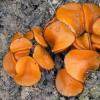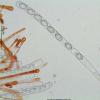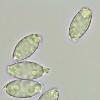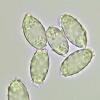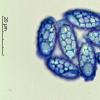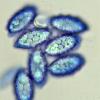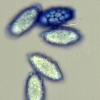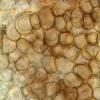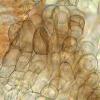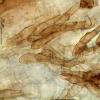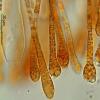
12-11-2021 00:03
Lepista ZacariasHi everybody,A week ago in my fiels trip I noticed

29-12-2025 17:44
Isabelle CharissouBonjour,J'aimerais savoir si d'autres personnes au

29-12-2025 17:12
 Bernard CLESSE
Bernard CLESSE
Bonjour à toutes et tous,Pourriez-vous m'aider à

29-12-2025 17:01
Gernot FriebesHi,I'm looking for help with this hyphomycete with

29-12-2025 08:30
Hello.A tiny ascomycete sprouting under Juniperus

29-12-2025 10:15
Hulda Caroline HolteHello, I found and collected this propoloid ascom

29-12-2025 09:38
Oskari VirtanenHi,could anyone help me identify this, I suspect P

Hola a todos.
Subo unas fotos de una Melastiza encontrada hace un par de días en suelo removido.
Esporas de 16-20 x 9,4-10,2 micras.
He visto en casi todos los ápices de las paráfisis una sustancia pegada, ¿cristales? ¿Es esto común?
¿Son sinónimos Melastiza chateri y Melastiza cornubiensis? ¿Cuál sería el prioritario?
Gracias por sus respuestas.
Rubén

with this ornamentation (low, regular, rather thin ribs of reticulum) and hair width over approx. 15 um, I'd call it M. cornubiensis (syn. M. chateri). That few collections I saw had a bit wider spores (I collect M. carbonicola much more frequently than this one, but that's perhaps more my preference of habitats than the fungus'), but their respective sizes are overlapping a lot anyway. See Moravec's last article on this genus: http://www.czechmycology.org/_cm/CM474.pdf
Viktorie

So, M. chateri is synonymous with M. cornubiensis. The priority name would be M. cornubiensis?
The link you sent does not work, do you have the document?
Can someone help me to know what is the substance of the apex of the paraphysis?
Thank you
Rubén

for the link you have to type manually [.pdf] in the end.
about the paraphyses I am not sure but they seems to be apically thick walled, to be sure if it is cell-wall material test with Congo-red. Otherwise it might be some gel layer over the hymenium.
cheers,
Stip


